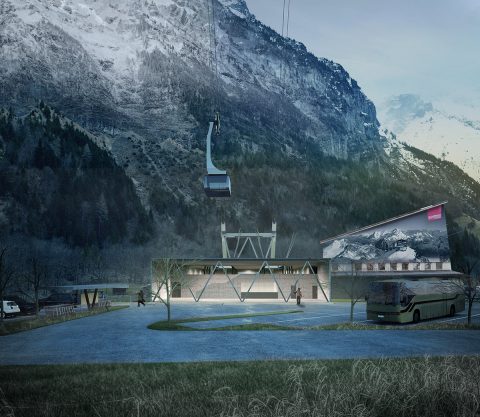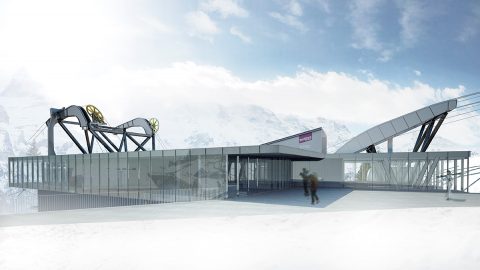Launch of the new SCHILTHORN 20XX cableway project
2nd October 2018
Category : News
Around 50 years after access to the Schilthorn – Piz Gloria was opened up by cable car, Schilthorn Cableway Ltd has presented the new project SCHILTHORN 20XX. The idea behind it is to replace the current cable car with a new aerial cableway. Based on the existing buildings and lines, the new infrastructure and cableway will ensure public transport connections to and from Gimmelwald and Mürren and optimize access to the Schilthorn – Piz Gloria excursion peak.
The current aerial cableway dates from 1965 (linking Stechelberg – Gimmelwald – Mürren – Birg) and 1967 (Birg – Schilthorn). While many electromechanical components have been continuously replaced, the structural infrastructure remains largely in its original state. The 2016 – 2026 financial plan includes age-related measures on the aerial cableway which are due to be implemented in the next few years to comply with existing regulations. The cableway has also comprehensively exhausted its capacity reserves. Today, the 100-passenger cabins can only carry a maximum of 80 passengers, due to increasing space requirements (passengers now weigh more on average; rising transport volumes of equipment for leisure activities etc.) At the same time, passenger numbers have risen both in summer and winter in recent years.
“In view of planned imminent and medium-term measures such as the replacement of suspension cables, the reinforcement of supports and the replacement of the cabin on the 4th section, it made sense, before investing in the wrong direction, to evaluate and explore the longer-term future of the aerial cableway as part of a master plan. In autumn 2017, we commissioned a preliminary project and cost estimate of the proposed master plan,” says Peter Feuz, Chairman of the Executive Board at Schilthorn Cableway Ltd. In order to achieve the best possible concept independently of manufacturer-specific systems, the contract to draw up a master plan and preliminary project was awarded to the engineering firm Tytec, Thomas Rentsch. Thomas Rentsch was the planner and project manager on the aerial cableway linking Arosa and Lenzerheide and has a proven track record as a creative cableway engineer.
Parameters of SCHILTHORN 20XX
The SCHILTHORN 20XX project proposes the construction of a new aerial cableway. The planned aerial shuttle cableway consists of 3 sections with 2 cabins each (Stechelberg – Mürren – Birg – Schilthorn). Its distinguishing feature is the replacement of the existing transport cableway from Stechelberg to Mürren by a new shuttle cableway as the 1st section, thus eliminating the need for a changeover. The upper 2 sections are proposed as 2 independently operating, single-track shuttle cableways. The new cableway system would ensure a continuous operation, making the Schilthorn accessible on 365 days a year.
The proposed new 3-section aerial cableway would ensure fast, direct and comfortable access to the excursion peak and ski slopes. Of particular importance is that the current sections 1 + 2 (Stechelberg – Gimmelwald – Mürren) of the old aerial cableway remain in operation and therefore ensure half- hourly public transport connections from Gimmelwald.
The planned cableway lines on all sections either follow the current lines or run parallel at a few metres distance. New technology means that the Mürren – Birg stretch can be implemented with just 1 instead of previously 2 supports and the optimized transportation capacity would eliminate bottlenecks in the higher part of the ski area in winter. On the Birg – Schilthorn section, the new cableway could even be constructed without supports.

Requirements placed on SCHILTHORN 20XX
“We are aiming for a better, not bigger, cableway,” emphasizes Schilthorn Cableway CEO Christoph Egger. “The trip to the Schilthorn summit comes at a price: it is important to us that this mountain experience also provides commensurate levels of comfort and quality,” Egger adds. This is reflected in the vision: “Through its services, Schilthorn Cableway Ltd ensures the transportation of local residents and visitors on the Stechelberg – Gimmelwald – Mürren route while making the mountain landscape of the southern Lauterbrunnen Valley accessible to tourism. Given its importance and size, the cableway plays a leading role in the local tourism industry. The company is using its influence to ensure that quality tourism continues to be offered.”
Schilthorn Cableway outlines the requirements placed on the new aerial cableway as follows:
- A reduction in travel time from 32 to 19 minutes between Stechelberg and the Schilthorn.
- Year-round access to the Schilthorn – Piz Gloria.
- Boosting passenger convenience by reducing changeovers and increasing the cabin space per guest (and possibly seating capacity).
- Increasing transportation capacity to 800 p/h (maximum 900 p/h).
- Increasing space at the station terminals.
- Optimizing goods and luggage transport from and to Mürren and achieving a complete separation from passenger transport.
The new cableway would also entail station modifications: “The project plan allows for the preservation and retained visibility of the heritage-protected elements of the Schilthorn Cableway,” Feuz says. This applies specifically to the concrete and steel structures of the stations. New elements aimed at optimizing passenger flow and separating goods and luggage transportation entail extending the buildings, all of which would be installed on the company’s own property.
“A 365-day operation would also enable company-internal improvements: maintenance and revision work, for example, could be carried out continuously and not just in the off-season, resulting in a more varied workload for the technical maintenance staff,” Egger adds.
Funding SCHILTHORN 20XX
“The Executive Board has designated maximum investment costs of CHF 90,000,000 for the project. These investment costs are affordable and sustainable, Peter Feuz explains. Preliminary talks with banks and major shareholders support this conclusion. There will be no departure from the conservative and prudent financial policy which the Executive Board has been pursuing for many years – a policy based on a high equity ratio and low total debt. Annual dividend payments at current levels will continue during the implementation of the project.

Project planning of SCHILTHORN 20XX
“The Executive Board stands unanimously behind the project and is confident that it will create added value for the population, guests, tourism destination and not least the employees of Schilthorn Cableway,” says Peter Feuz. “We have intentionally named the project SCHILTHORN 20XX, as the information, approval and tendering procedures will be followed by a staged construction schedule. It isn’t necessary right now to determine the exact construction timeframe,” Christoph Egger explains. The individual sections are to be implemented in separate stages. The company plans to install temporary transport cableways from Stechelberg to Mürren and from Mürren to Birg and the Schilthorn for the duration of the work, in order to avoid interruptions to tourist passenger traffic and ensure that materials are not transported through or over Mürren village by heavy goods vehicle or helicopter.
Planning approval for SCHILTHORN 20XX
The new cableway requires two-tiered planning approval:
– The municipal land use planning process involves determining and defining a cableway corridor and the station locations in compliance with building regulations. This is a cantonal procedure.
– The cableway construction plans must be reviewed and approved at federal level. In addition to numerous technical considerations, environmental compatibility and various specialist reports (geology, natural hazards, etc.) are reviewed and considered in the assessment of the project.
At municipal level, public participation in land development planning is expected to take place in Lauterbrunnen as early as autumn 2018.